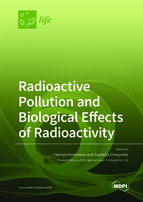Radioactive Pollution and Biological Effects of Radioactivity
A special issue of Life (ISSN 2075-1729). This special issue belongs to the section "Radiobiology and Nuclear Medicine".
Deadline for manuscript submissions: closed (30 November 2022) | Viewed by 37329
Special Issue Editors
Interests: applied physics; radioactivity; environmental radiation; radon gas; ionizing radiation; radioactive pollution; numerical analysis; time series analysis; neural networks; machine learning; Montecarlo simulation; software development; data processing; geogenic phenomena; Earth rotation (Length of the day - LOD)
Special Issue Information
Dear Colleagues,
We are pleased to invite academic scientists, researchers, and scholars from all over the world to contribute articles, reviews, or case reports, based on high-quality research works, to the Special Issue of the journal Life on “Radioactive Pollution”.
Radioactive pollution occurs when radioactive elements enter the atmosphere and reach the Earth’s surface, within solids, liquids, or gases, including the human body. This happens after natural and/or man-made activities, such as nuclear tests, industrial waste (e.g., radiodiagnostics), and excesses of naturally occurring radioactive sources. This kind of pollution entails risks of radiological contamination of the environment, with harmful effects on human health caused by the ionizing radiation. This theme has become even more current due to the increasing use of ionizing radiation for domestic, industrial, and medical purposes during the last century. Radiological monitoring is a primary objective of radiation protection in order to estimate and understand the impact of radionuclides on the environment and to assess the health risk for the population.
The aim of this Special Issue is to provide an interdisciplinary platform for researchers to exchange and share their experiences and latest achievements on all aspects of radioactive pollution. Survey data analysis, original and unpublished results of conceptual, constructive, empirical, experimental, and theoretical work are welcome, and other concepts related to the radiation field will also be considered.
Dr. Fabrizio Ambrosino
Prof. Supitcha Chanyotha
Guest Editors
Manuscript Submission Information
Manuscripts should be submitted online at www.mdpi.com by registering and logging in to this website. Once you are registered, click here to go to the submission form. Manuscripts can be submitted until the deadline. All submissions that pass pre-check are peer-reviewed. Accepted papers will be published continuously in the journal (as soon as accepted) and will be listed together on the special issue website. Research articles, review articles as well as short communications are invited. For planned papers, a title and short abstract (about 100 words) can be sent to the Editorial Office for announcement on this website.
Submitted manuscripts should not have been published previously, nor be under consideration for publication elsewhere (except conference proceedings papers). All manuscripts are thoroughly refereed through a single-blind peer-review process. A guide for authors and other relevant information for submission of manuscripts is available on the Instructions for Authors page. Life is an international peer-reviewed open access monthly journal published by MDPI.
Please visit the Instructions for Authors page before submitting a manuscript. The Article Processing Charge (APC) for publication in this open access journal is 2600 CHF (Swiss Francs). Submitted papers should be well formatted and use good English. Authors may use MDPI's English editing service prior to publication or during author revisions.
Keywords
- radioactivity in medicine
- radionuclides in the atmosphere
- radiation sources
- nuclear power plant
- radioactivity monitoring
- biological impact of ionizing radiation
- radioactive particles characterization
- radioactive waste disposal
- radioecology
- radioactive contamination








